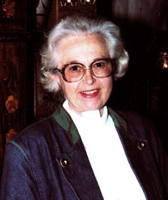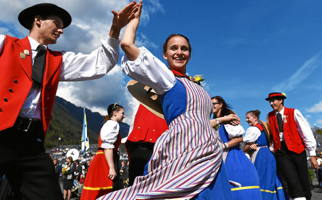
|
Folk Dance Federation of California, South, Inc.
|

|
CLICK AN IMAGE TO ENLARGE
The dances of Eastern Switzerland are very similar to those of alpine Germany and Austria, while the dances of the western cantons are related to those of France, and in the south to those of Italy. Most Swiss dances are couple or group dances using the steps of the popular ballroom dances of the 19th century: Mazurka, Waltz, Polka, Schottische, and Gallop. Perhaps, because of the austerity of the Calvinist period, few traditional dances survived and many of the contemporary Swiss folk dances are reconstructions based on traditional dance figures that were collected and set either to traditional tunes or to melodies especially composed for these dances.
Very few ritual dances have remained and those are usually danced at 'driving out winter' ceremonies, Carnival, spring and harvest celebrations and at the time of the ascent and descent of the cattle from the high pastures. There is literary evidence that Switzerland still knew 'dances of death' until the middle of the last century. One such source is Gottfried Keller. In his novel Der grune Heinrich he describes a funeral dance:
"... we immediately hurried outside to where, on the corridor and stairs, the crowd began to pair off and form a procession, for without a partner no one was allowed to go up. I took Anna by the hand and fell into line which began to move, led by the musicians. They struck up a lugubrious mourning march, to the rhythm of which we marched three times around the attic, which had been converted into a ballroom, and formed a large circle. Hereupon seven couples stepped into the centre and executed a lumbering old dance with seven figures and difficult jumps, kneefalls and intertwinings, accompanied by resounding clapping. After the spectacle had gone on for some time, the host appeared and went through the rows thanking the guests for their sympathy; here and there whispering into the ear of a young man – in such a way that all could hear – that he should not take the mourning too much to heart and to leave him (the host) alone with his grief. Moreover, the host walked away and climbed down the stairs with lowered head as if they led directly to Tartatus. The musicians suddenly switched to a gay 'Hopser', the older people withdrew, and the young swept shouting and stamping across the groaning floor . . ."
 In character, Swiss dances are more sedate and earthbound than their German counterparts. Among folk dance groups, great emphasis is placed on precision of detail in the placement of hands and arms and in the holds between partners.
In character, Swiss dances are more sedate and earthbound than their German counterparts. Among folk dance groups, great emphasis is placed on precision of detail in the placement of hands and arms and in the holds between partners.
The Swiss Folk Dance Movement has from its inception been a branch of the SchweizerischeTrachtenvereinigung (the Swiss Costume Association, now called the Swiss National Costume Association) which fosters and encourages the practice of all aspects of folk art. One of the pioneers in the field of Swiss folk dance was Luise Witzig. After having come in contact with the German and English folk dance movement, she recognized the importance of folk dance research and its significance to the work of the Costume Association. She began to conduct dance workshops in which she transmitted the results of her research work. This in turn encouraged others to collect and notate existing material within their immediate areas. The Swiss Costume Association then made it its task to systematically collect old tunes and dance figures which were still to be found especially in the alpine areas.
Already in 1935 it was possible to publish the first collection of dance notations. Since then, this organization has released records as well as books and pamphlets on the dances of all cantons. It also conducts annual folk dance leader training courses and folk dance workshops; always insisting on high standards of accuracy and precision.
Alongside the folk dance movement of the Swiss Costume Association, there exists Arbeitsgemeinschaft Schweizer Volkstanzkreise (the Association of Folk Dance Groups) which is a collective member of the Swiss Costume Association. This organization was formed in 1956 and consists of independent dance groups who practice all forms of European folk dancing and sponsor specialized workshops in the dances of a given country, conducted by an expert in that particular field. The objectives and practices of the Folk Dance Association are very similar to the recreational folk dance movement in the United States.
Printed in Folk Dance Online,
Volume 51, Number 2, April 2020.
Reprinted from Ontario Folkdancer, January 1991
Used with permission.